Choosing the right heat pump can make a big difference when it comes to keeping your home in Mount Uniacke comfortable year-round. With temperatures shifting throughout the seasons, it is important to have a system that adjusts easily without wasting energy. Many homeowners find themselves unsure about which type of heat pump matches their home, their comfort needs, and their long-term goals. A mismatch could lead to higher power bills or a system that struggles to keep up.
The key is to take a closer look at how heat pumps work and how different models can match specific needs. That means thinking about how big your home is, how it was built, and what kind of weather it faces. The right decision starts with understanding the basics, then narrowing it down based on what fits best with your space and your comfort goals.
A heat pump moves heat from one place to another. In the winter, it takes heat from outside and brings it into your house. In the summer, it moves heat out of your home to help cool it down. This movement of heat is what makes heat pumps different from systems that generate heat by burning fuel or using electricity to produce warmth.
There are two main styles found in homes across Mount Uniacke:
1. Air-source heat pumps: These are the most common, pulling heat from the outdoor air even when it is cold. Modern units can work efficiently in low temperatures, which makes them a good option in much of Nova Scotia.
2. Ground-source (or geothermal) heat pumps: These use the stable temperature underground to manage heating and cooling. Pipes are buried in the yard, and the system pulls or pushes heat using fluids underground. These systems tend to require more space and upfront planning.
Both of these give homeowners the ability to use one system during both summer and winter. That saves physical space at home and makes it easier to keep things running with one system instead of several.
Before getting a heat pump installed, it helps to make sure your home is set up to get the most from it. Not every system works the same way in different homes. Here is what to look at if you are in Mount Uniacke and thinking about your options:
- Home size: A small house may only need one mini-split, while a larger home might require multiple indoor units or central ductwork.
- Insulation levels: Older homes may lose heat quickly, so upgrading insulation could improve performance.
- Existing HVAC setup: If you already have ductwork, a central system could work. If not, ductless models may be a better fit.
- Local climate: Mount Uniacke’s winters can get cold, so it is worth picking a model that performs well even in low outdoor temperatures.
- Energy priorities: If reducing energy use is a main goal, look for a system with a high efficiency rating and variable-speed compressor.
For example, someone living in a two-storey home built in the 1980s might struggle with uneven heating upstairs. In that case, a ductless solution could give better control, especially if insulation upgrades are not being done. Each home is different, and what works for one might not work for another.
Taking these points into account can help avoid getting a unit that is too big, too small, or simply not right for how you live. It also sets the stage for fewer repairs, lower utility bills, and a system that works the way you expect.
When comparing different heat pumps, it is easy to get overwhelmed by the technical terms and variations. Breaking it down helps make the process more manageable. Each type of heat pump fits a different kind of home setup. Choosing the right one depends on how your home is built, your comfort needs, and your expectations for efficiency.
Here are the most common types:
- Air-source: These are best for homes with enough outdoor wall space for mounting units. They work well for moderate climates and are generally easier to install.
- Ductless mini-splits: Ideal for homes without ductwork. They offer individual zone control, which helps in rooms that heat or cool unevenly.
- Geothermal: These require digging into the ground for pipe installation. They cost more to set up but are quiet and consistent throughout the year.
Once you choose a type, there are some important features worth checking out:
- Inverter technology: This helps adjust compressor speed based on demand, which makes the system more efficient and keeps indoor temperatures steady.
- Smart thermostats: These can be useful for controlling your heat pump remotely or setting schedules based on your routine.
- Quiet operation: Look for systems designed to keep outdoor and indoor noise levels low, especially if units are placed near bedrooms.
- Cold climate performance: Models rated for cold climates are especially important in Mount Uniacke, where winter temperatures can dip well below freezing.
Selecting a unit that matches your real-life needs goes a long way in achieving comfort throughout the year without overpaying on your energy bill.
Proper installation is just as important as choosing the right model. Even the best heat pump will not run well if it is installed improperly. Issues like incorrect sizing or poor airflow setups can lead to noisy systems, rising bills, and uneven temperatures.
That is where our technicians play a key role. They make sure every stage of the installation is done the right way:
- Checking your home's layout and selecting the right location for indoor and outdoor units
- Making sure the system matches your home’s heating and cooling load
- Sealing connections and testing refrigerant levels to avoid leaks
- Confirming that your electrical setup can support your heat pump’s needs
- Providing clear instructions on how to use your new system efficiently
Many homeowners in Mount Uniacke may not realize why their heat pump does not perform well until an inspection shows it was not installed correctly. Avoiding that problem starts with getting the installation done by trusted professionals right from the beginning.
Even efficient systems need the right upkeep to stay that way. A good heat pump can last a long time, but only if it is maintained. Daily use adds wear and tear that, if ignored, can lead to breakdowns or high power bills.
These are the most impactful maintenance steps:
- Clean or replace filters every one to three months
- Keep the outdoor unit clean and free from debris
- Schedule an annual inspection by our professionals to check for refrigerant leaks, connection issues, and thermostat accuracy
- Keep vents or indoor units clear of furniture or blockages to allow smooth airflow
If your home suddenly feels stuffy or your system cycles on and off too often, those are signs something is not working like it should. Addressing issues early saves time and money in the long run.
Getting a heat pump is a smart first step, but the benefits build over time with proper use. There are a few ways to keep your system working well, especially through Mount Uniacke’s changing seasonal demands.
One of the most helpful tips is to adjust your thermostat settings gradually. Constantly changing settings or turning the unit off and on shortens the compressor's life. Setting it and letting it run steadily uses less energy overall.
It is just as important to pay attention to how the system feels around your home. If certain rooms stay too hot or too cold, or if your bills rise even though your usage has not changed, it is time to have a technician check the system’s airflow and balance.
One Mount Uniacke homeowner noticed higher bills within a year after their unit was installed. They assumed the system was faulty, but it turned out the outdoor unit was partly blocked by overgrown shrubs. Once cleared, energy use returned to normal. Small details like this can have a big effect.
Investing in a heat pump is about comfort, reliability, and long-term value. When the right system is selected and installed correctly, it will work quietly in the background, keeping your space comfortable every day of the year.
Homeowners in Mount Uniacke can expect consistent heating and cooling, but those results depend on making the right choices early on. That includes picking a model that fits your home’s layout, using features suited to your needs, and keeping up with simple routine maintenance.
With expert advice and proper setup, your heat pump can become an asset that works efficiently and reliably for years to come.
If you are looking for a dependable and energy-efficient way to maintain year-round comfort, our professionals are here to help with expert heat pump installation in Mount Uniacke. Trust the team at Presidential Ventilation Systems Ltd. for a seamless experience from selection to setup. For a quick estimate or to book a service visit, please contact us today.
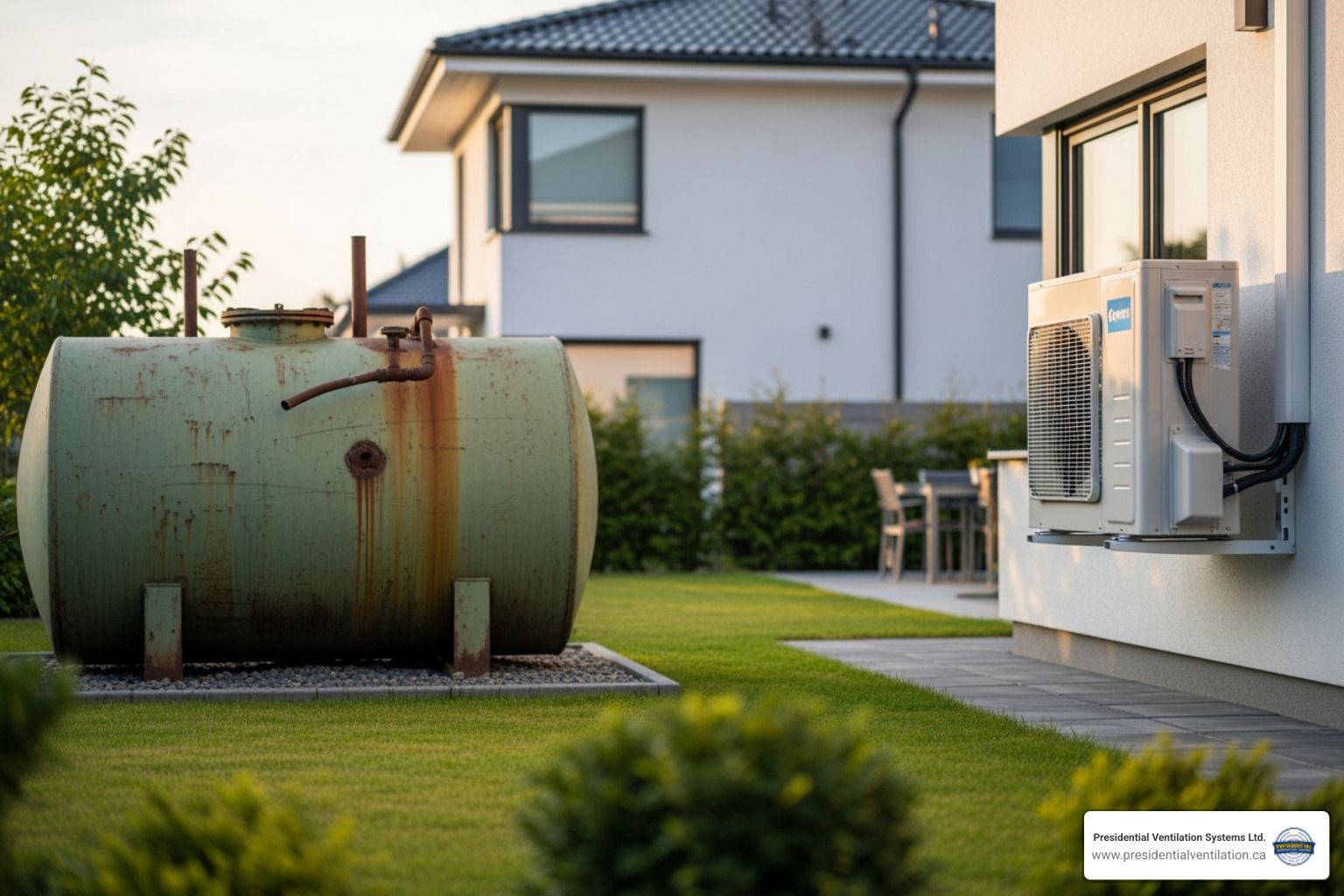

An oil to heat pump upgrade in Halifax NS is one of the most popular home improvements for Nova Scotians. The switch is about smarter energy use, lower bills, and year-round comfort. Here are the key benefits of upgrading:
Halifax's climate makes this transition particularly attractive. Modern cold-climate heat pumps work efficiently even when temperatures drop well below freezing, and government programs like the Oil to Heat Pump Affordability (OHPA) Program make the investment more accessible than ever.
With oil prices fluctuating and environmental concerns growing, more than 10,000 Nova Scotians have already applied for heat pump conversion programs. The transition has reduced greenhouse gas emissions by thousands of metric tonnes while putting money back in homeowners' pockets.
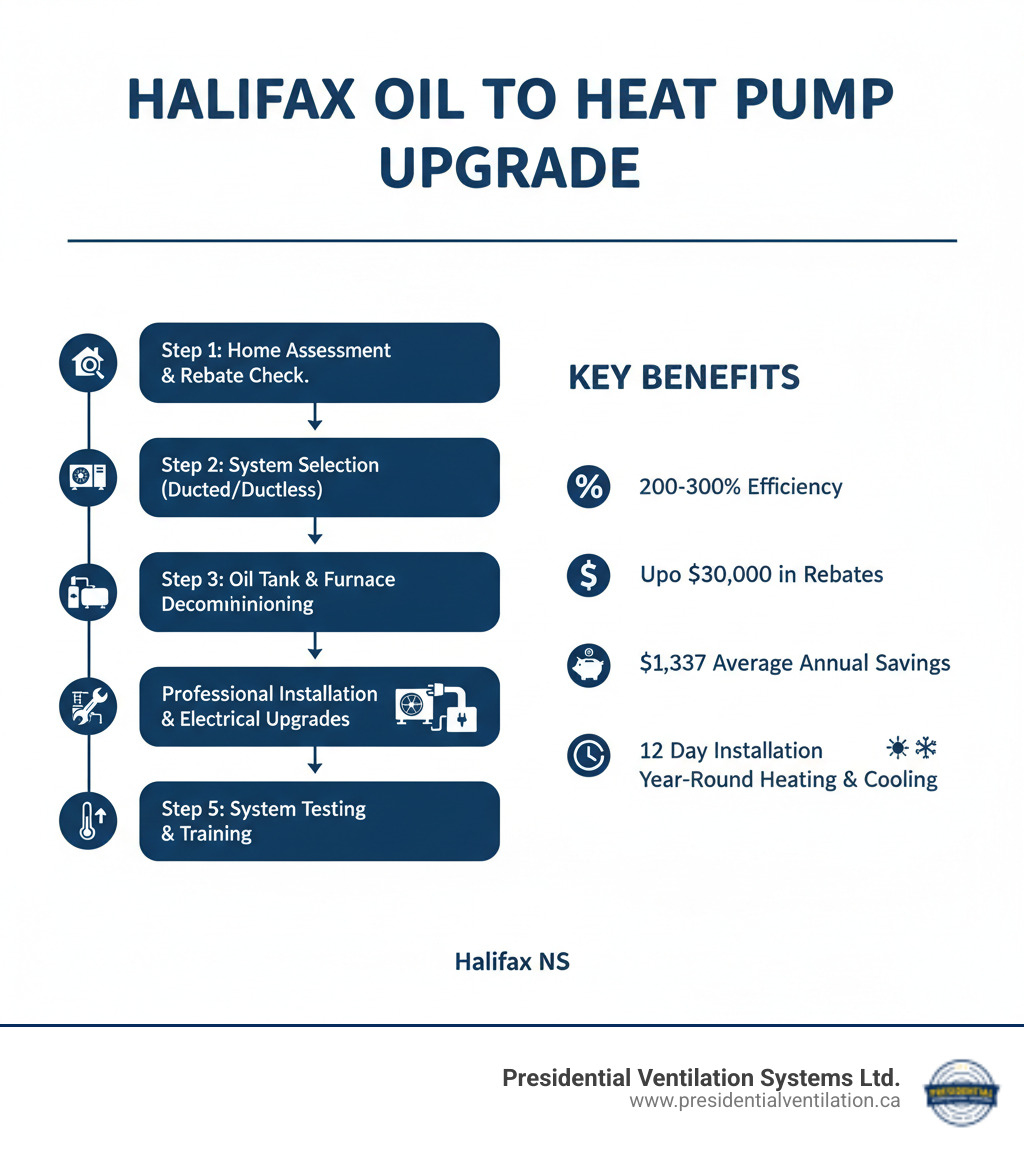
At Presidential Ventilation Systems Ltd., we have over 30 years of experience helping Halifax families make the switch, enhancing their comfort and reducing energy expenses. We guide you through every step of your oil to heat pump upgrade in Halifax NS.
Traditional oil furnaces operate at 65-85% efficiency, meaning a significant portion of energy is lost as waste heat. In contrast, heat pumps don't generate heat—they transfer it. In winter, they extract heat from the outside air and move it indoors. In summer, they reverse the process for cooling. This allows heat pumps to achieve 200-300% efficiency ratings. For every unit of electricity consumed, they deliver two to three units of heating or cooling.
This efficiency means heat pumps can use up to 70% less energy than oil heating systems. Modern cold-climate air source heat pumps are designed to operate efficiently even when temperatures drop significantly below freezing. To learn more, you can learn about heat pump efficiency in extreme temperatures.
An oil to heat pump upgrade in Halifax NS offers substantial long-term savings and a positive environmental impact. Homeowners can save up to 50% on heating costs, with an average of $1,337 saved annually. Since heat pumps also provide cooling, you eliminate the need for a separate air conditioning unit, leading to more year-round savings.
Environmentally, switching from a fossil-fuel-burning oil furnace to an electric heat pump eliminates combustion and drastically reduces your home's carbon footprint. This transition can cut a household's emissions by almost 3 tonnes annually. For a deeper dive, explore the environmental benefits of upgrading your furnace.
Here's a quick comparison:
| Feature | Oil Furnace | Heat Pump |
|---|---|---|
| Efficiency (%) | 65-85% | 200-300% |
| Annual Savings | Fluctuating | Up to 50% (Avg. $1,337) |
| Environmental | High CO2 emissions | Low/Zero CO2 emissions* |
| Cooling Capability | None | Yes |
| Maintenance | Frequent (soot, filters) | Less frequent (filters, check-ups) |
| Fuel Source | Fossil Fuel | Electricity |
*Depends on electricity source. Nova Scotia is increasingly integrating renewable energy into its grid.
For more details on making the switch, check out our guide on more info about switching to a heat pump.

An oil to heat pump upgrade in Halifax NS is more affordable than you might think, thanks to generous government programs. Federal and provincial initiatives like the Oil to Heat Pump Affordability (OHPA) Program and Efficiency Nova Scotia offer eligible Halifax residents combined funding of up to $30,000.
These programs are designed to remove financial barriers, with the average grant for heat pump installation sitting around $7,158. This can significantly reduce your out-of-pocket expenses and help you move toward a cleaner, more efficient heating solution.
Navigating rebate programs can be complex, but we're here to help. To find out what rebates you qualify for and how we can guide you through the application process, visit our page on heat pump rebates in Halifax NS.
The Oil to Heat Pump Affordability (OHPA) Program is a game-changer for Halifax homeowners. This federal program, delivered in Nova Scotia through Efficiency Nova Scotia, targets low- and median-income households who need financial support to switch from oil.
The program provides up to $15,000 in funding to cover a comprehensive range of costs. This includes the new cold-climate heat pump and its installation, necessary electrical upgrades, and the safe removal of your old oil tank. It can also cover supplemental electric heating systems and the switch of other oil-using appliances like water heaters.
A key feature is the availability of upfront payments for eligible customers. This means funding can go directly to your contractor, so you don't have to pay thousands out of pocket and wait for reimbursement. Some programs also include complimentary energy-efficiency upgrades like LED lighting and smart thermostats.
To explore the full details, we encourage you to learn more at the official OHPA Program page.
Eligibility for Nova Scotia grants like the OHPA program is straightforward. Here are the main requirements:
Before applying, gather your Notice of Assessment, a Nova Scotia Power bill, proof of home ownership, and oil purchase receipts to make the process smoother.
While the Canada Greener Homes Grant is no longer accepting new applications, the OHPA program remains a fantastic opportunity. You might also qualify for an interest-free loan of up to $40,000 from the Canada Mortgage and Housing Corporation (CMHC) for additional upgrades. You can check your eligibility for the Canada Greener Homes Loan for more information.
Understanding the process is the next step after deciding to switch from oil to a heat pump. At Presidential Ventilation Systems Ltd., we make your oil to heat pump upgrade in Halifax NS as smooth as possible. Our certified professionals manage every detail, from the initial assessment to final testing.
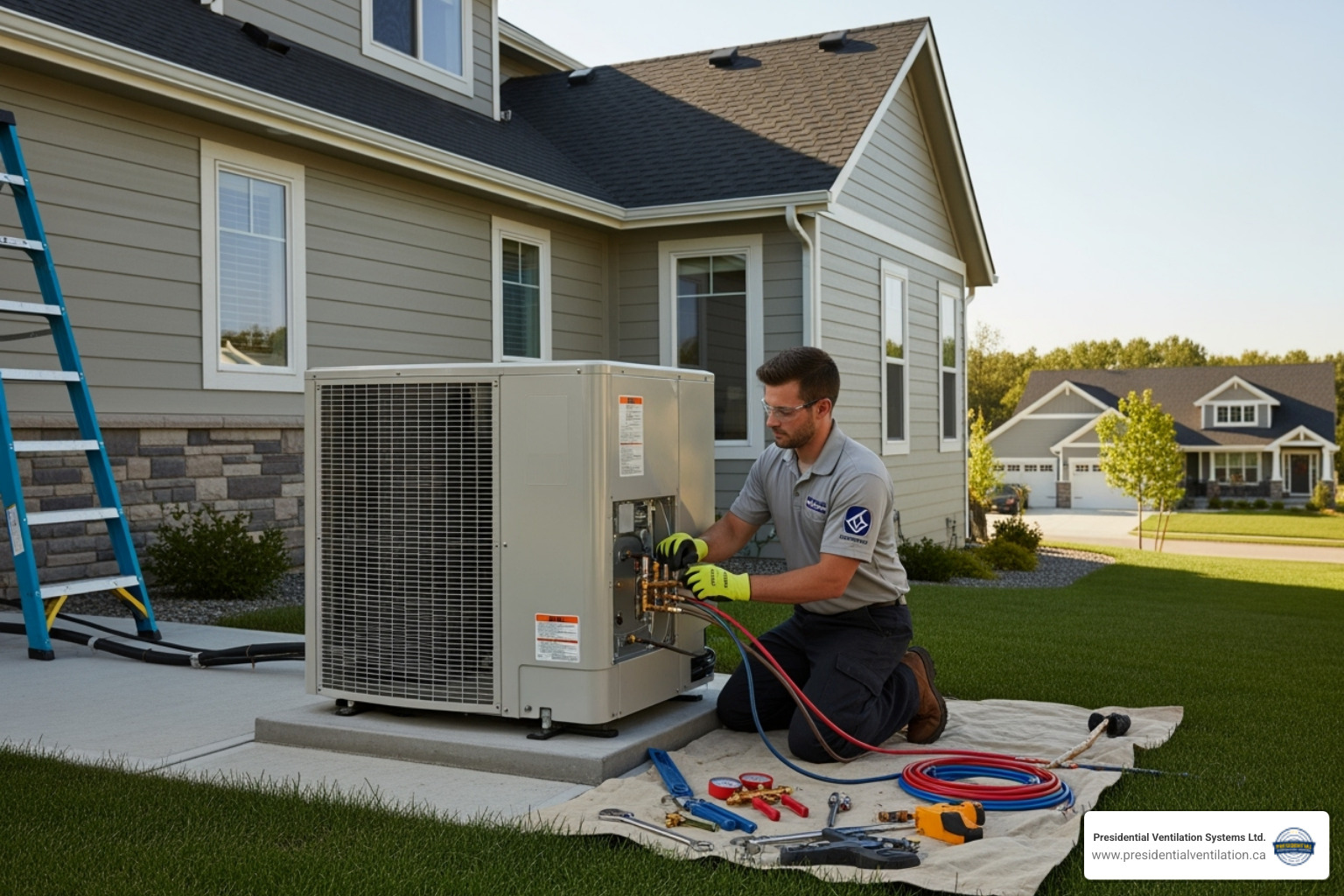
With over 30 years of experience, we've refined the conversion process to take the guesswork out of your hands. To see how we deliver top-tier service, view our heat pump installation services in Halifax.
Converting from oil to a heat pump is a straightforward process with the right team. Most installations are completed in just 1-2 days, minimizing disruption. The process includes:
Halifax's climate demands a system that can handle both cold winters and humid summers. Modern cold-climate heat pumps are designed for this, with some models operating effectively down to -30°C.
When planning your oil to heat pump upgrade in Halifax NS, you'll choose between two main types:
Ducted Heat Pumps: Ideal for homes with existing ductwork, these systems provide consistent, whole-home heating and cooling by integrating with your current setup. They offer a familiar feel with superior efficiency. You can explore our ducted heat pump systems to learn more.
Ductless Mini-Split Heat Pumps: Perfect for homes without ductwork or for zoned climate control. An outdoor unit connects to one or more indoor units, allowing independent temperature control in different rooms for improved comfort and energy savings. Read our ductless heat pump Halifax guide for a comprehensive look.
Proper sizing is critical. An incorrectly sized unit will operate inefficiently and wear out prematurely. Our experts perform detailed calculations to ensure your system is perfectly matched to your home.
One of the benefits of an oil to heat pump upgrade in Halifax NS is simpler maintenance. Oil furnaces require frequent cleaning of soot and residue, along with filter changes and annual tune-ups to prevent breakdowns. Heat pumps, on the other hand, are much less demanding.
Heat pump maintenance is straightforward:
Overall, heat pump maintenance is simpler and generally less expensive than for an oil furnace, but regular care is key to protecting your investment for 15-20 years or more. To keep your system running smoothly, schedule your heat pump maintenance in Halifax with our team.
Choosing the right professional for your oil to heat pump upgrade in Halifax NS is crucial, as the quality of the installation determines your system's performance and longevity. Here’s what to look for in an HVAC partner:
At Presidential Ventilation Systems Ltd., we bring all these qualities to every project. We're not just installing equipment—we're partnering with you to create a more comfortable and efficient home. To see how we can help, see our comprehensive HVAC services in Halifax.
It's natural to have questions when considering a major home project like an oil to heat pump upgrade in Halifax NS. Here are answers to some of the most common questions we receive.
Yes, a modern cold-climate heat pump will absolutely keep your home warm and comfortable throughout a Halifax winter. These systems are specifically engineered to perform in freezing temperatures, with many models operating efficiently down to -25°C or -30°C. Even at -18°C, the air still contains 85% of the thermal energy found at 21°C, and heat pumps are designed to extract this energy. For rare instances of extreme cold, a supplemental electric heating source can be integrated as a backup, ensuring you always have the heat you need. For more on this, read our guide: Do I need a backup source of heat?.
Professional decommissioning and removal of your old oil furnace and tank is a standard part of a complete oil to heat pump upgrade in Halifax NS. Our certified technicians manage this process safely and in compliance with all environmental regulations. Any remaining oil is removed, the tank is cleaned, and both the furnace and tank are removed from your property for responsible disposal. The cost of this service is often covered by government rebate programs like the Oil to Heat Pump Affordability (OHPA) Program, making the transition seamless and affordable.
The physical installation of your oil to heat pump upgrade in Halifax NS is surprisingly quick. While the overall process includes an assessment and planning phase for system selection and rebate applications, the actual installation typically takes just 1 to 2 days. The exact timeline depends on the system type (ducted or ductless) and whether electrical upgrades are needed. Our technicians work efficiently to minimize disruption to your daily life. After installation, we conduct thorough system testing and walk you through its operation to ensure you are completely comfortable with your new system.
An oil to heat pump upgrade in Halifax NS is a smart investment in your home's comfort and efficiency. You gain a system that operates at 200-300% efficiency, saving an average of $1,337 annually on heating costs. You also get the year-round benefit of heating and cooling from a single, reliable unit.
By eliminating fossil fuel combustion, you'll reduce your household's CO2 emissions by nearly 3 tonnes each year, contributing to a greener Halifax. With up to $30,000 in combined rebates available through programs like the OHPA Program, this upgrade is more accessible than ever.
At Presidential Ventilation Systems Ltd., we have over 30 years of experience helping Halifax families make this transition. Our certified experts handle everything, from the initial assessment and rebate applications to the safe removal of your old oil tank and professional installation of your new system. As a leading Daikin Comfort Pro Dealer, we back our work with exceptional service and comprehensive warranties.
You've lived with fluctuating oil prices long enough. It's time for a more comfortable, efficient, and sustainable home. Trust the team that Halifax homeowners have relied on for decades.
Ready to transform your home's comfort and start saving? Contact us to discuss your furnace replacement in Halifax NS today. We're here to help you make the switch with confidence.
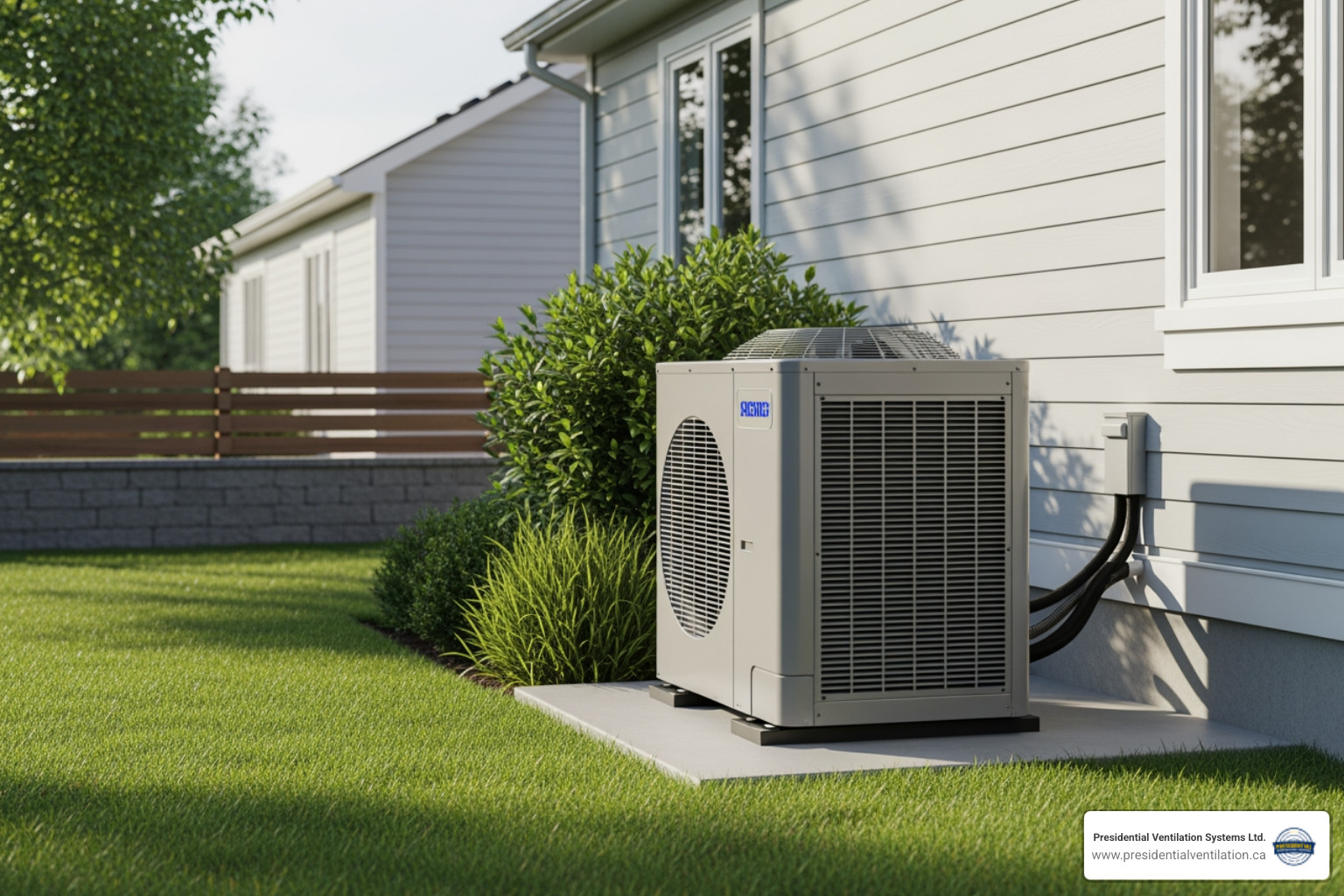

The fan on my outdoor heat pump unit stopped working. Who does heat pump fan replacement near Timberlea? If you're facing this problem, you need a qualified refrigeration technician to diagnose and replace the failed fan motor safely. In Timberlea and the Halifax Regional Municipality, certified HVAC professionals service major heat pump brands, including Daikin, Fujitsu, Mitsubishi, and Lennox. A broken outdoor fan is a serious issue that can cause your compressor to overheat and fail, turning a simple repair into an expensive replacement.
Quick Answer: Who Can Help You Now
For comprehensive information on heat pump systems, visit our Heat Pumps Halifax NS page, or get immediate help by contacting our Heat Pump Service team.
A non-working outdoor fan is a common but critical issue that can stop your heat pump from heating or cooling your home. This guide covers the signs, causes, and solutions for homeowners facing this problem.
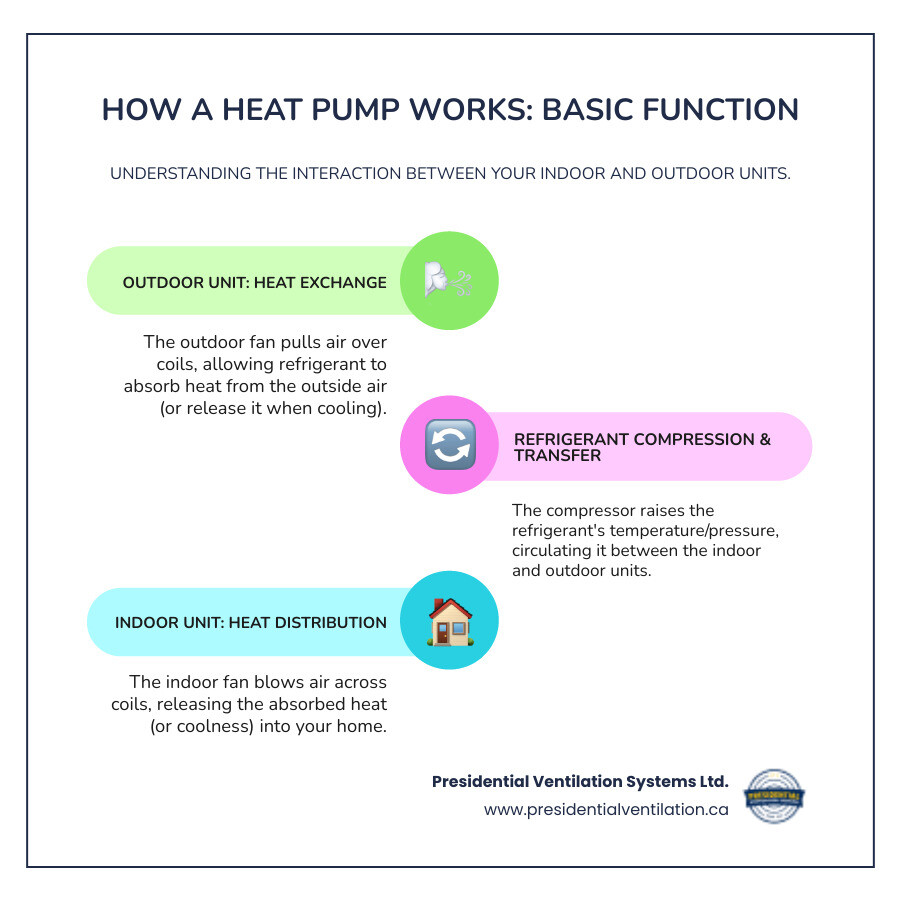
When the fan on your outdoor heat pump unit stopped working, your system can't function correctly. The good news is that your heat pump usually provides warning signs before a complete failure. Catching these early can prevent a minor issue from becoming a major repair.
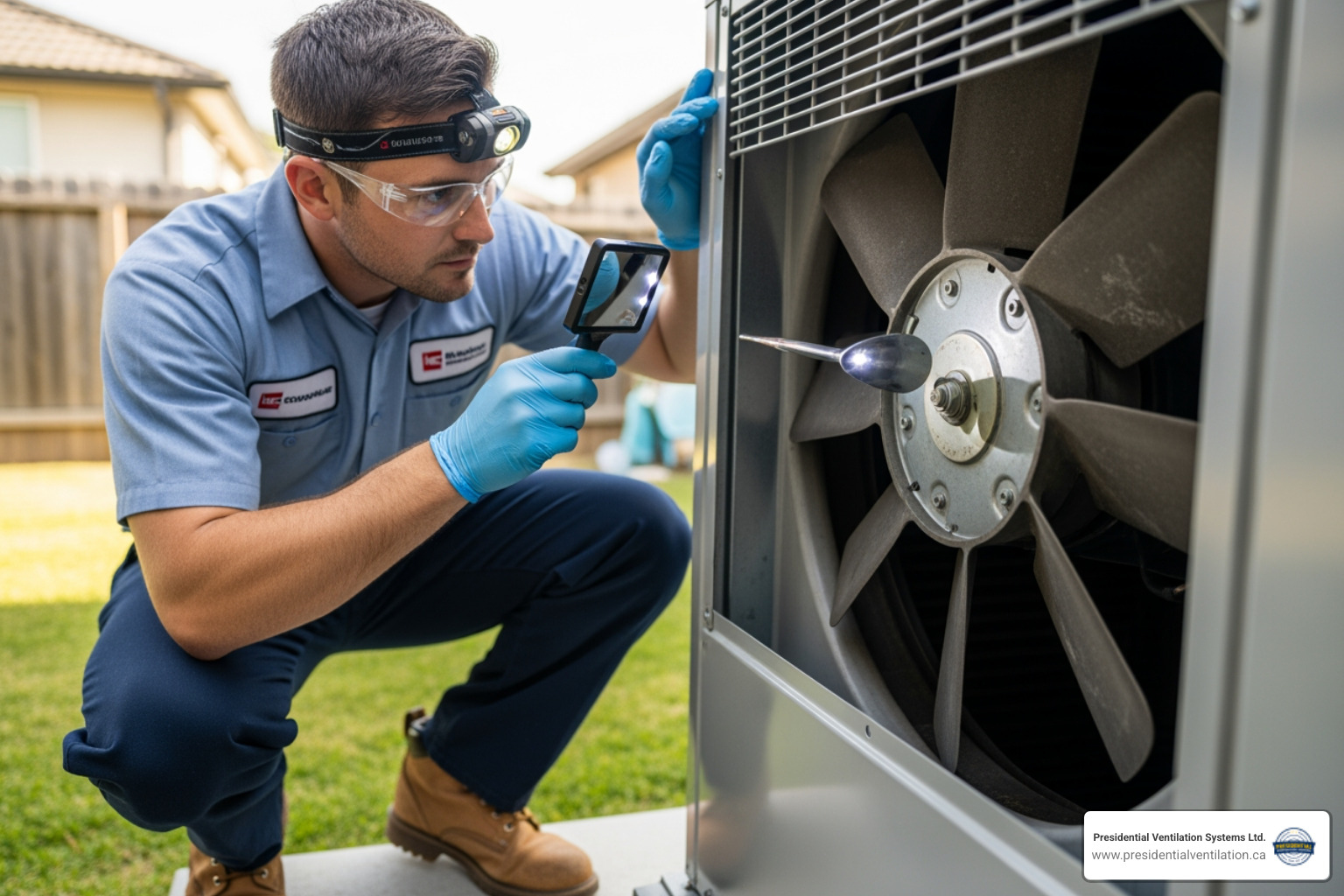
The most obvious sign is that your fan blades aren't spinning. If the unit is making noise but the blades are still, you have a problem. You might also notice your unit humming but the fan remaining motionless. This sound is often the compressor trying to run without the critical airflow the fan provides.
Another sign is that your system might start frequently shutting down. This is a safety feature to prevent overheating. When the fan doesn't spin, the unit gets too hot and shuts down to protect itself. In colder weather, you might see ice buildup on your outdoor coils. Without airflow from the fan, the unit can't defrost properly, causing ice to accumulate rapidly.
The impact on your comfort is unmistakable: inadequate heating or cooling. The indoor unit may blow air, but it won't be at the right temperature because the heat exchange process has stopped. Before the fan fails completely, you might hear strange noises like grinding, squealing, or rattling. These are signs of mechanical issues, such as worn bearings, warning you that a failure is imminent.
If you notice any of these symptoms, especially a stationary fan, don't wait. The longer you delay, the more damage your system can sustain. For more information, see our guide on Signs Heat Pump Needs Immediate Attention.
Your outdoor fan motor works hard year-round. Eventually, components can fail.
Understanding these causes highlights the importance of regular maintenance. For more insight, check out our articles on Top Reasons Heat Pumps Fail and Common Heat Pump Issues.
A heat pump running without its fan is like a car engine running without coolant—catastrophic damage can happen quickly. Before you consider a DIY fix to save money, it's crucial to understand the risks involved.
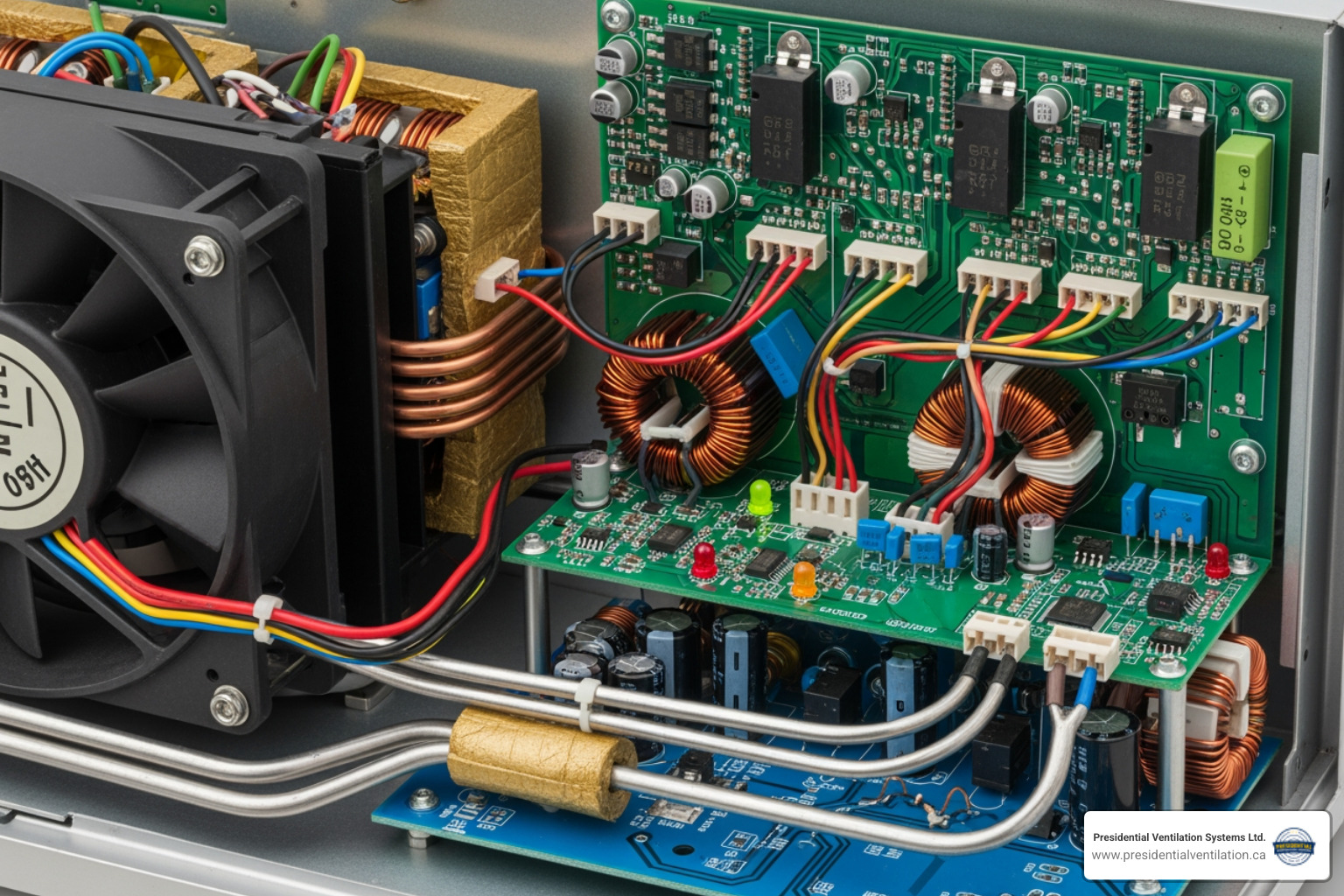
The outdoor fan is essential for your heat pump's survival. When it stops, your system enters a danger zone.
Compressor overheating and failure is the most critical risk. The fan's job is to pull air over the coils to dissipate heat. Without it, the compressor—the heart of your system—quickly overheats. This leads to permanent internal damage. Replacing a failed compressor is one of the most expensive heat pump repairs, often approaching the cost of a new outdoor unit.
This leads to complete system failure, leaving you with no heating or cooling. The extreme temperatures also put immense pressure on refrigerant lines, potentially causing leaks. Furthermore, the constant overheating and shutting down stresses other electrical components like relays and control boards, turning a single problem into a system-wide failure.
The bottom line: running your heat pump with a broken fan is a costly gamble. Shut down your system immediately if the fan on your outdoor heat pump unit stopped working. For more guidance, visit our Heat Pump Troubleshooting Call Our Technicians page.
Replacing a heat pump fan motor is more complicated and dangerous than it appears. Here’s why a professional repair is the smart choice.
DIY Risks:
Professional Service Benefits:
For a critical system like your heat pump, professional service is the only choice that protects your investment and ensures your safety. Learn more in our Heat Pump Fan Replacement Complete Guide.
When your outdoor heat pump fan fails, you need a fast, reliable solution. At Presidential Ventilation Systems Ltd., we have over 30 years of experience helping homeowners in Timberlea and throughout Nova Scotia. We understand the urgency when the fan on your outdoor heat pump unit stopped working and are here to provide expert service.
Grinding, squealing, or rattling sounds are urgent warning signs. They are your system's cry for help before a complete breakdown.
Turn the system off immediately at the breaker to prevent further damage. This is the most important step you can take. Do not just turn off the thermostat; cut all power at your electrical panel. Once the system is safely off, give the unit a quick visual check for obvious obstructions like branches or heavy ice, but do not attempt any repairs yourself.
As soon as the system is secured, schedule a Heat Pump Service appointment. The sooner a professional diagnoses the issue, the better the chance of avoiding a catastrophic compressor failure.
Our comprehensive service is designed to restore your system to peak performance. Here’s our process:
Servicing a heat pump requires specialized knowledge. Here’s what to look for:
When your heat pump fan gives out, finding a qualified technician in your area is key. You need prompt, professional service from someone who knows your heat pump brand and can get to you quickly.
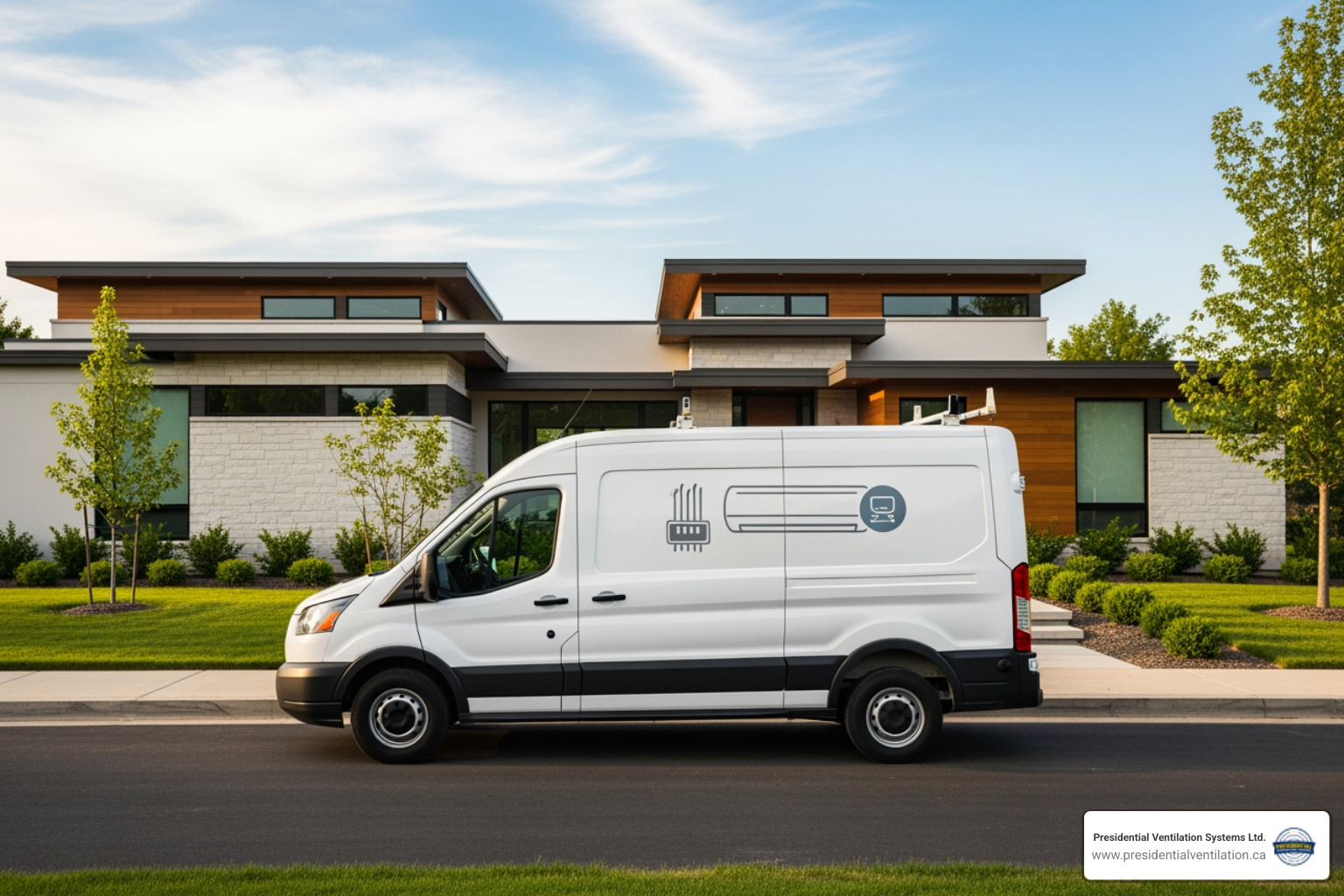
An experienced HVAC service provider can handle most heat pump brands. Our technicians are proficient in servicing and repairing fan issues for virtually all major makes and models, ensuring we can help no matter what system you have.
We regularly service Daikin, Fujitsu, LG, Mitsubishi, Lennox, and Goodman systems. We also work on York, Moovair, Tosot, GE, Direct Air, Novair, Samsung, Panasonic, Rudd, Trane, Carrier, Rheem, Bryant, and Amana units. Our breadth of expertise means we have the knowledge and access to the right parts to repair your specific unit correctly and reliably.
While your immediate concern is "The fan on my outdoor heat pump unit stopped working. Who does heat pump fan replacement near Timberlea?", our service area extends throughout the Halifax Regional Municipality and surrounding communities.
We regularly serve homeowners in Timberlea, Halifax, Dartmouth, Lower Sackville, Middle Sackville, Upper Sackville, Clayton Park, Beaver Bank, Bedford, Cole Harbour, Eastern Passage, Fall River, Tantallon, Lawrencetown, Waverley, and Mount Uniacke. We also reach communities like Indigo Shores, Lacasville, Prospect, Hubbards, Sambro, Herring Cove, Hatchet Lake, Williamswood, East Dover, Indian Harbour, Spryfield, Otter Lake, Fairview, Terence Bay, Porters Lake, Preston, Peggys Cove, Harrietsfield, Woodlawn, Shearwater, and Burnside.
Whether you need Heat Pump Repair Halifax NS, Heat Pump Repair Dartmouth NS, Heat Pump Repair Mount Uniacke NS, or HVAC Services Bedford NS, our team is ready to bring our expertise to your doorstep.
While some fan failures are due to age, many can be avoided or delayed with proactive care. Preventative maintenance is the best way to keep your outdoor fan motor running reliably.
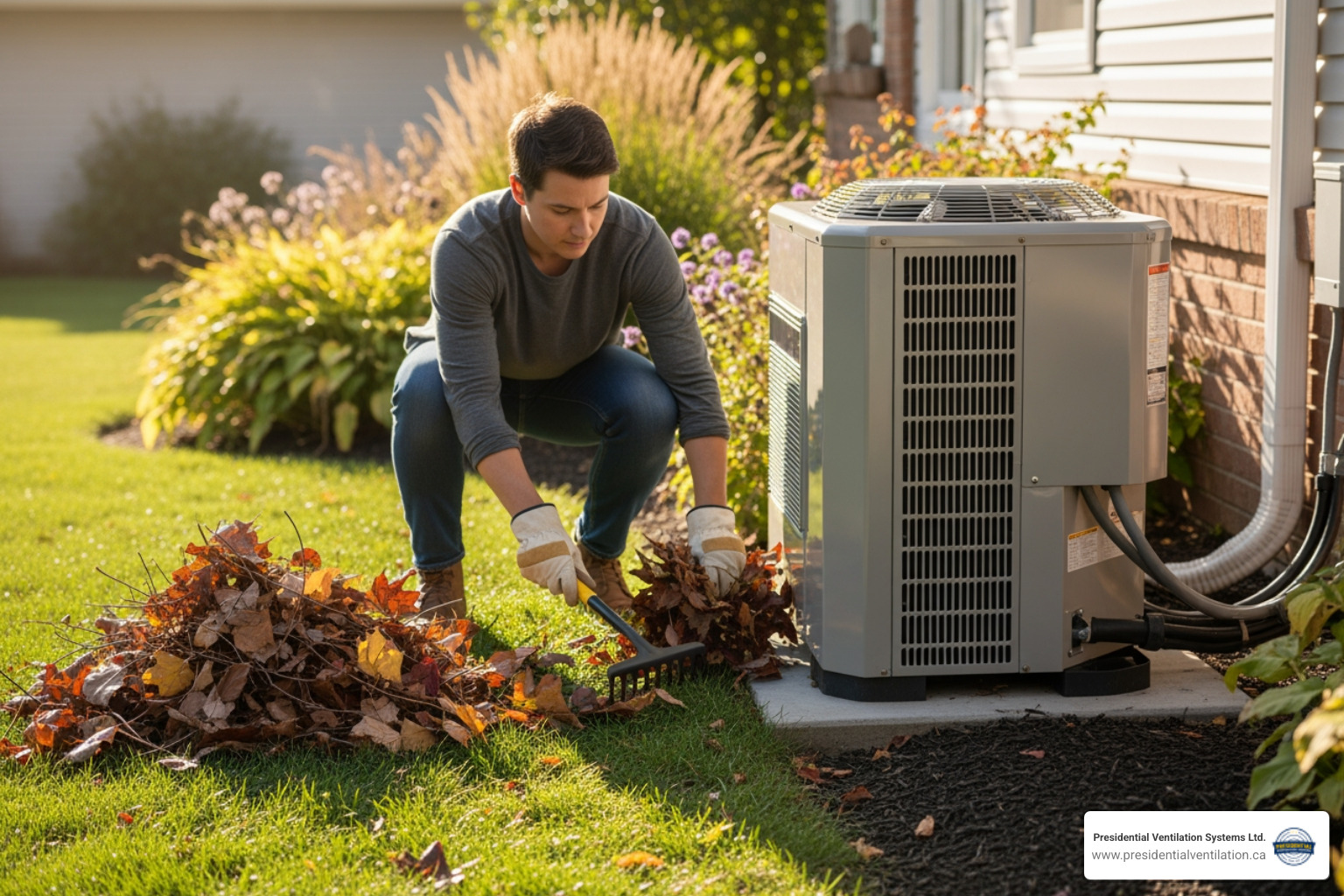
Yes, regular upkeep is key to extending the life of your heat pump's outdoor fan motor and preventing unexpected breakdowns.
Here are our top preventative maintenance tips:
Regular professional maintenance improves efficiency, extends your heat pump's lifespan, and helps prevent costly repairs. It’s an investment in comfort and savings. For more details, read our blog on Why Heat Pump Maintenance Is Essential and consider booking an Annual Heat Pump Tune-Up. You can also learn about services in your area, like Heat Pump Maintenance Halifax NS.
A broken heat pump fan is an urgent problem. The fan on my outdoor heat pump unit stopped working. Who does heat pump fan replacement near Timberlea? If you're asking this, you've come to the right place. Attempting a DIY repair is risky and can lead to more expensive damage, such as a failed compressor.
The safest, most effective solution is to contact a qualified professional. You need an expert who can diagnose the problem accurately, source the correct parts, and complete the repair safely.
At Presidential Ventilation Systems Ltd., we understand the vital role your heat pump plays in your home's comfort. With over 30 years of experience serving homeowners throughout the Halifax Regional Municipality, our Red Seal Certified refrigeration mechanics provide expert service for all major heat pump brands, from Daikin and Fujitsu to Mitsubishi, Lennox, and beyond.
When you choose us, you're choosing proper part sourcing, expert installation by certified professionals, and thorough system testing. We don't just replace a part; we ensure your entire system operates at peak efficiency, protecting your investment.
Don't let a non-working fan compromise your comfort or lead to catastrophic damage. For expert diagnosis and reliable Heat Pump Repair in Timberlea NS, trust the certified technicians at Presidential Ventilation Systems Ltd. to restore your home's comfort quickly and safely. Whether you're in Timberlea or need service for your Heat Pumps in Halifax NS, we're here to help.
Contact us today and let us take the stress out of your heat pump repair. We're here to help you stay comfortable, season after season.